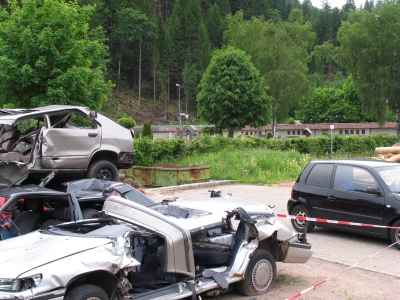For Henk Jan Nix, General Secretary of the European Group of Automotive Recycling Associations (EGARA), the solution is obvious: “We need registration systems which track vehicles during their entire life thus ensuring that the vehicles will be sent only to officially recognised end-of-life vehicle dismantlers,” he stated at today’s IARC press conference.
Nix also had another suggestion for beating the illegal car buyers and that is to pay the last owners a better price. However, that is only possible if dismantlers are able to recover all of the reusable parts, to enable them to get the full value out of the end-of-life vehicle. “In order to do so, we need more information from manufacturers about the various parts.” The European Group of Automotive Recycling Associations does not expect to receive this information for nothing. “We are willing to pay for this information,” Nix emphasised.
Gareth Williams from European Metal Recycling also sees financial rewards as a method of providing last owners with an incentive to dispose of their vehicles through approved channels. “One such way would be to introduce a type of road fund levy that is then paid to the last owner when it is disposed of properly,” explained Williams, the Marketing & Communications Director for the EMR Group. Denmark has experiences with such system and apparently a level of 300 € premium to the last owner seems sufficient.
That would also be of benefit to end-of-life vehicle dismantling companies, as illegal operations pose an existing threat to reputable recyclers. “Those people who do not follow the required processes for disposing of end-of-life vehicles do not have the overheads that we have and therefore can afford to pay more for these vehicles,” said Williams. The result: “A great many end-of-life vehicles go missing every year, all over Europe, which means we cannot run our plants at full capacity.”
Dr Georg F. Mehlhart from Oeko-Institut gave an estimate of the number of end-of-life vehicles that actually disappear via dubious means. The Senior Researcher for Resources & Mobility assumes that between 10 and 12 million end-of-life vehicles are generated across the EU each year. Some 1.2 million of these are exported outside the EU as used vehicles before becoming waste. Around six million are officially reported and treated according to the requirements of the ELV Directive. “The whereabouts of around four million vehicles per year in the EU is not known, which means that the fate of some 40 million vehicles remains unresolved over the last ten years.”
In order to plug this leak, the researcher sees it as necessary to improve not only the data situation, but also the exchange of data at EU level. The enforcement of EU regulations also needs improving at member-state level. “This includes measures such as field inspections in the sector at spare parts sellers, repair shops and garages.” Mehlhart also sees the export regulations as another possible starting point. “We might think about age limitations for vehicle exports, or at least about stricter conditions for export, such as a valid roadworthiness test as a condition for export. This is necessary by air pollution and car safety reasons as well.”
Getting more end-of-life vehicles into the official recycling channels also requires better cooperation, urged Stig Thorlak from the Danish producer responsibility system “DPA System” at the press conference. “The real payoff will only come when the corporations, suppliers, sub-suppliers, dismantlers, authorities and policymakers start to cooperate to get more end-of-life vehicles into the recycling chain.”
”The companies can’t do it by themselves,” Thorlak emphasised. “We need the policymakers to facilitate and push the behaviour towards a circular and sustainable mindset. It goes for the producer as well as the vehicle owner.” Here too, money plays a role that should not be underestimated, which is obvious when looking at the situation in Denmark, where vehicle owners receive a reimbursement of 300 euros when handing over an end-of-life vehicle to a dismantler.






